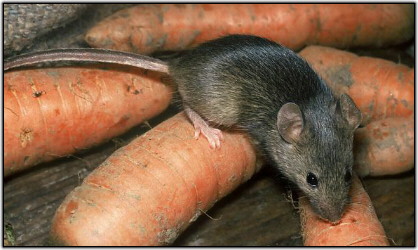House Mouse
 The house mouse is common in all parts of Canada. The house mouse is dusty grey in colour and measures from 10 to 15cm in length with large ears and small eyes. The tail is usually the same length as the mouse. The house mouse is sometimes confused with the deer mouse, which is pale grey to reddish brown in colour and has a bi-coloured tail, with a white underside.
The house mouse is common in all parts of Canada. The house mouse is dusty grey in colour and measures from 10 to 15cm in length with large ears and small eyes. The tail is usually the same length as the mouse. The house mouse is sometimes confused with the deer mouse, which is pale grey to reddish brown in colour and has a bi-coloured tail, with a white underside.
Mice are nibblers and thus tend to make small holes or other slight damage in many places rather than a lot of damage at one place. The house mouse has a keen sense of touch, smell and hearing. They can run, climb, jump and swim very well.
The house mouse is considered one of the major structural pests, causing serious economic loss, health hazards and an unsanitary environment.
House mice eat about the same food as humans, including cereals, seeds, fruits and vegetables and are especially fond of sweet liquids. Because they nibble, they may feed as often as 15 to 20 times each day consuming only a small amount of food each time.
 Life Cycle
Life Cycle
The average lifespan of a mouse is 12 months. The young are born about 20 days after breeding and mature rapidly. A single female may have as many as eight litters per year, averaging five to six young each.
By three months, the young are independent and capable of reproduction. Mice can survive outdoors during the winter under certain conditions, but generally invade buildings when the weather turns cold.
Habits and Health Hazards
Since the contributing factor to a mouse infestation is the presence of food, good housekeeping is essential. This includes the proper storage of foods in sealed jars or tins. In addition, all refuse should be stored in containers with tight-fitting lids.
Mice cause extensive damage to houses, granaries, restaurants, bakeries; any place food is handled or stored. They will gnaw through wood to gain entrance into buildings. In constructing their nests, mice will destroy fabrics and leather goods and can cause fires by chewing through the insulation on electrical wires.
 Mice contaminate food with their droppings and urine. They spread such diseases as salmonella bacteria, lepospirae and typhus. As well, they carry parasites such as fleas, round worms and mites. Deer mice are known to transmit Hantavirus, a virus that affects the respiratory system of humans.
Mice contaminate food with their droppings and urine. They spread such diseases as salmonella bacteria, lepospirae and typhus. As well, they carry parasites such as fleas, round worms and mites. Deer mice are known to transmit Hantavirus, a virus that affects the respiratory system of humans.
Mice are year-round pests. Activity and indoor migration increases, as weather gets cooler. Mice become active primarily during the evening and remain so until the middle of the night. If food is scarce or the infestation is large, they will be active during daylight hours. Mice become active primarily during the evening and remain so until the middle of the night. If food is scarce or the infestation is large, they will be active during daylight hours.
 Mice nest in any safe location close to food, preferring the spaces in double walls, above ceilings and floors and closed-in areas around counters. Noises made by their running, gnawing and scratching will provide clues to their actual location. There are several ways that mice make their presence known. Mouse droppings near available food are the most common indication. Gnawed holes in bags and boxes containing food or garbage are also a sign of mouse activity.
Mice nest in any safe location close to food, preferring the spaces in double walls, above ceilings and floors and closed-in areas around counters. Noises made by their running, gnawing and scratching will provide clues to their actual location. There are several ways that mice make their presence known. Mouse droppings near available food are the most common indication. Gnawed holes in bags and boxes containing food or garbage are also a sign of mouse activity.
DOWNLOAD MORE INFO ON THE SPCA’S BEST PRACTICES FOR MICE & RATS

